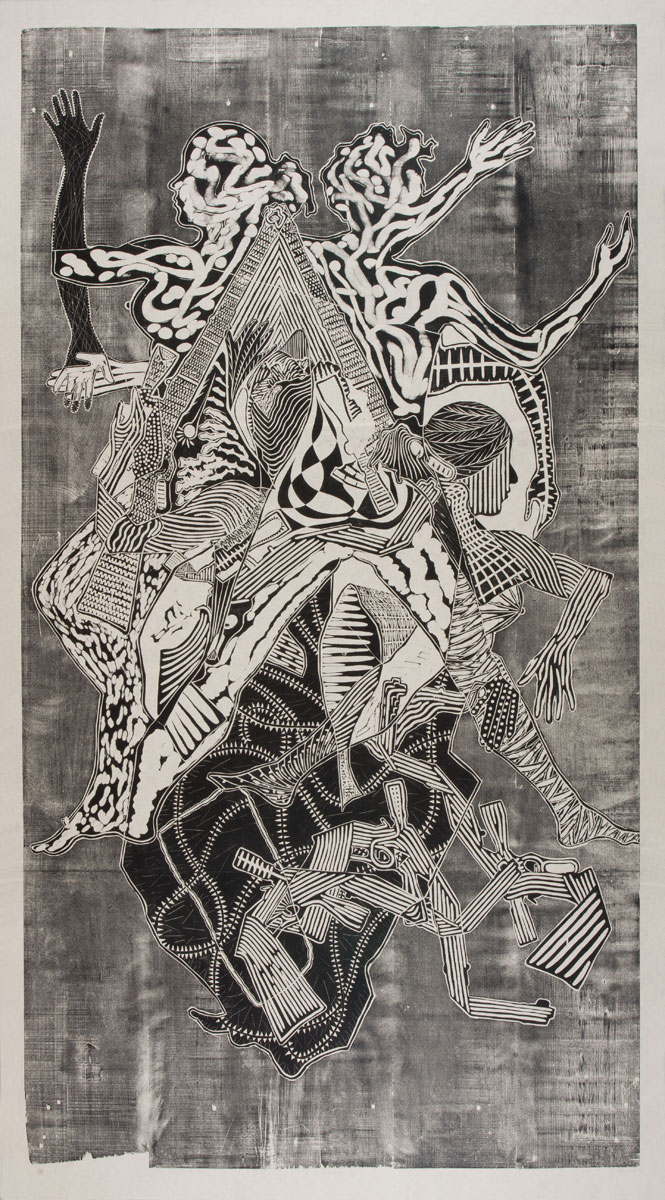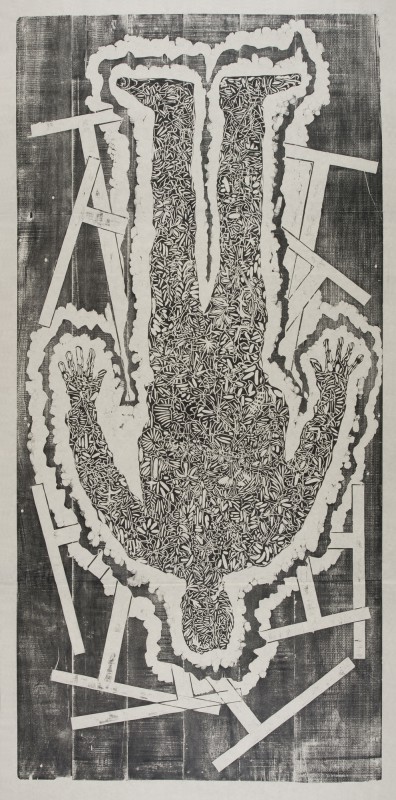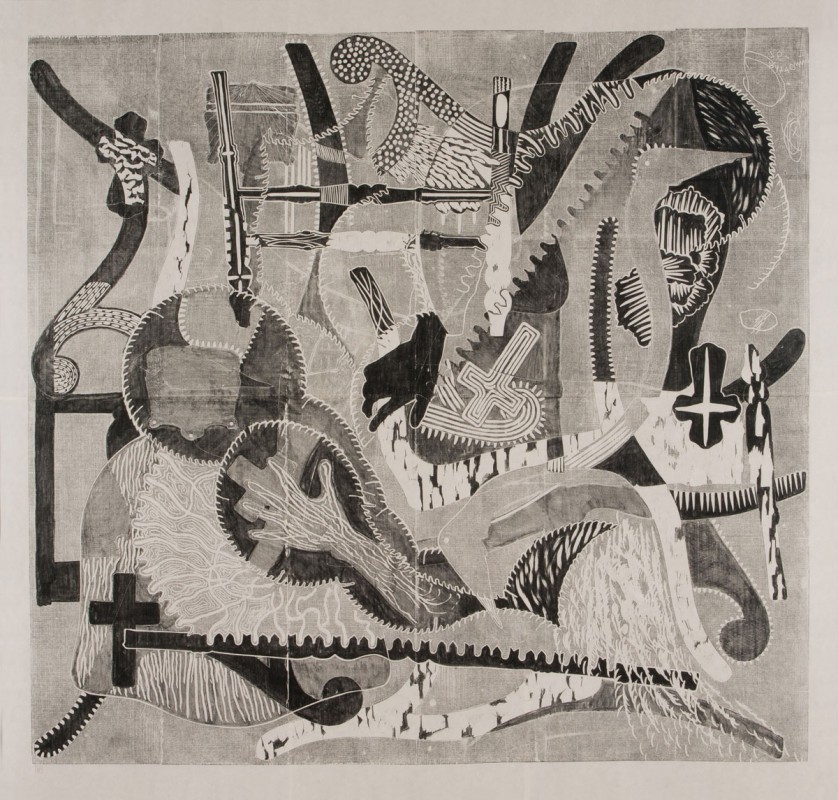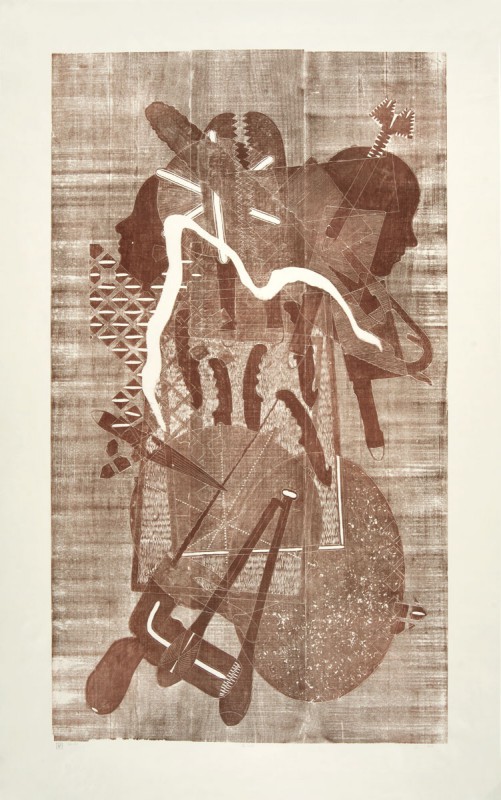Myths for the Modern Age
On Aaron Spangler's latest body of woodcut prints, which articulate a vision of contemporary myth by way of ancient byways of the human imagination.

In a sense, myth gives us our sense of reality. Before truth, before all arguments about truth, myths serve as both the signposts and collective expression of our most fundamental behaviors and deep-seated urges. We enact these myths in the daily ceremonies and patterns of habit, in our day-to-day interactions, perceptions and speculations. Even now, from the brutal war for the American frontier to Vietnam, to the bombing of Baghdad, we continually project the fantasy of manifest destiny via force, guided ever forward on that path by the empty promise of nuclear supremacy. We’re trapped between a tragic past and impossible future, ensnared in an impotent present. It is as if we are afraid to ask, individually or collectively: What are my true desires? Where are the myths to guide me? What can I do before it’s too late?
Make no mistake, Aaron Spangler’s current exhibition of 10 handprinted woodcuts doesn’t answer any of these questions. On the contrary, the artist has carved an impressive path charting the various grainy currents that course straight through such queries, through those byways of the imagination that flow to and from the strange territories we usually avoid in our workaday lives. Carved into single slabs of wood, then printed by hand with the skilled printmakers at Highpoint Center for Printmaking, Spangler’s works are impressive in their scope and technical achievement (three of them measure over 100 inches). These pieces speak a hybrid language of ancient craftsmanship and utterly modern confusion, saturated in the nuanced metaphors of images – images that resist the confines of literalist interpretations and open, instead, into the dark ocean of mythic imagination. Spangler seems to understand well the inevitability of metaphor; all myths speak its language. Whether we acknowledge it as such or not, from the Myth of Sisyphus to the Myth of Corporate Competition, we are forever and always in the grip of some variant on these ancient stories.

Aaron Spangler, Waiting In Line, woodcut, 2014. Image: David Kern
In Separatist (2014), a large diamond-like form dominates the field: it’s an opening of sorts, a cornucopia spilling torsos, arms, legs and various appendages. This central mass pulsates, surrounded in a diffuse field of grey ink. Two figures, facing in opposite directions, flank the uppermost tip of the diamond, arms raised up and out, as if in offering or embrace. The interior of their bodies is filled by a venous, flowing tangle of lines following the contours of their gestures. A third figure, tightly bound by the rigid patterns in and around her form, emerges from the middle right of the diamond. Legs, feathers, and vaguely archaic patterns twist and turn throughout the composition, trailing out of it in all directions. All angles and organic curve, it’s the image of hardware intersecting the wetware of consciousness — a superstructure that embraces the power of splitting, doubling, moving through reflection into memory. One could imagine the squabbling ideologies of our times — Anarchism and Libertarianism, Christianism and Atheism – so rendered, fantasies of longing for separation from the tangled mess of here and now, atrophied into a single lump of vicious stupidity. But a deterministic reading of Spangler’s imagery is too glib – we’re slaves of neither our genes, our machines, nor our economies. What is “natural” is what we imagine and create. After all, nature has no laws, only habits. Spangler’s work here echoes that sentiment, its figures simultaneously separate and coalesce, paradoxically rippling through these confusions with a morphic resonance that both draws on and contributes to the shared well of memory his imagery calls to mind.
 Aaron Spangler, Fence Lines, woodcut, 2014. Image: David Kern
Aaron Spangler, Fence Lines, woodcut, 2014. Image: David Kern
Ours is a culture enamored of boundaries, and we are the faithful, true believers in its tidy silos of understanding, neat taxonomies and well defined categories. But such boundaries are themselves articles of faith, another myth to live by. Nothing is so fixed or certain when our immediate experience of the world stands under its own reflection, separate from these constructs of understanding. Only instinct remains. It’s an easy thing to lose sight of when we spend our days laboring inside city walls. We lose sight of so much of the world – indeed, we block the view with the psychic walls we continually build around ourselves, blinders for anything that might upset the comfortably contained bounds of our worldview.

Aaron Spangler, The Wall, woodcut, 2014. Image: David Kern
Is there a more powerful metaphor than the wall? It is the boundary, separating the known from the unknown, us from them. Racism, religion, politics – all of them tend toward dogma, toward the tyranny of the wall. In his woodcut, The Wall (2014), Spangler offers his own take on the myth of boundary. He does so with a strange grace that speaks less to the authority of the tyrant than it does to that of the realized self. The only work in the exhibition printed in sepia tones, The Wall is an insurrection against the platitudes of boundary. As in the other works, many images are layered and locked together in the composition. Two silhouetted faces, facing opposite directions, flank the knot of forms. Patterns, tools, and weapons float in and out of focus within the field. Easily discernable phalluses become the tips of arrows and knives, at once penetrating and balancing the whole of the image. In its dance with absurdity, the work seems determined to sift through the detritus of times, tribes, and cultures – including our own – for still-viable fragments of meaning. His efforts call to mind William Blake’s caution to create your own system lest you be a slave to someone else’s.
Whether it’s with tongue in cheek or not, true to the title of the exhibition, Spangler’s affection for Luddism is evident; it’s even used as a tactic throughout this work. His medium of choice, woodblock printing, is itself an ancient practice — one requiring skill, simple tools, long hours, and patience. As now ubiquitous new media/social media technologies are increasingly used to suppress, surveil, and censure those who don’t conform, the archaic technology of woodblock printing gives Spangler’s work a refreshing freedom — a hands-on, unmediated immediacy with which to carve out his own mythologies into physical space. His is a daring declaration of self-liberation requiring a lot of dead wood to be jettisoned, the walls of literalist thinking to be toppled, and that some risky ideas be embraced. After all, there is no humanity without techne – but, Spangler’s images remind us, there is no techne worth more than one’s own humanity.
Related exhibition information:
Luddite: New Prints by Aaron Spangler was recently on view at the Highpoint Center for Printmaking in Minneapolis. See more of the artist’s work online here.
Craig Olson is an artist and writer living in Minnesota.